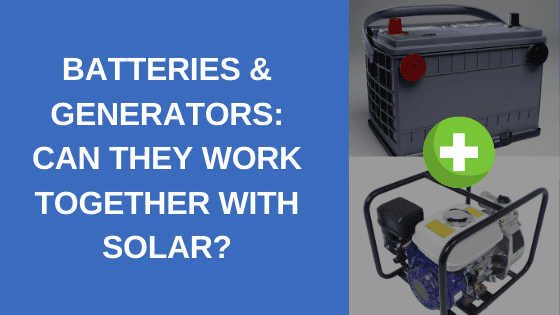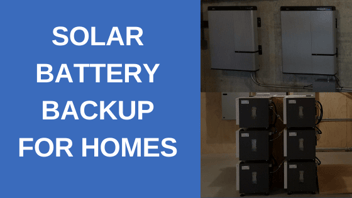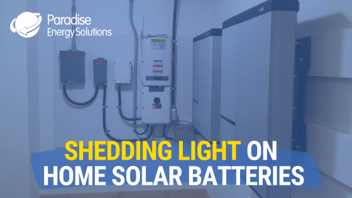No one likes to be unprepared. Whether it’s severe storms, downed trees, or even a car accident, power outages are unpredictable, and they can range from being a slight inconvenience to being downright dangerous.
Over the past few years, battery technology has emerged into the mainstream with dropping costs and increasing efficiencies, offering solar owners another way to protect themselves from the issues of losing power.
Learn More: What Happens to Your Solar Panels in a Power Outage?
Despite declining costs, a battery backup system can still be very expensive, and a generator is dependent on outside fuel sources that can give off harmful fumes. Depending on your situation, one of these options may be perfect for you. If not, what about a combination of the two?
Let’s take a look at how solar batteries and generators can work together to keep your home or business running no matter what situation comes your way.
How Much Can You Back Up with Batteries?
The power goes out for days, but life goes on as normal as your battery-backed solar system powers your entire home or business. While this probably sounds great to every solar owner, unfortunately, it’s not a reality for most - at least not yet.
While costs have declined to make batteries far more accessible in recent years, their price still limits their use. For many people, solar batteries are used for powering essential devices and appliances only. This could be things like medical equipment, lighting, a refrigerator, and a sump or well pump for a few hours.
It takes a lot of money to install enough batteries to store the energy needed to run your home or business like normal. One 9.8 kWh battery is about $15,000 with installation costs before incentives. And if you’re adding batteries to an existing system, you may need to purchase new inverters and other equipment on top of the battery itself.
Here’s a quick look at how much batteries will cost you and what you can expect to run with them:
|
Number of Batteries
|
Install Costs (Before Incentives) |
Install Costs (After 26% Tax Credit)* |
Estimated Total Usable kWh |
What That Can Power**
|
| 1 x 9.8 kWh Battery |
$15,000 |
$11,100 |
9.3 kWh |
A load of clothes in the washing machine and dryer, plus an hour of oven use |
| 3 x 9.8 kWh Batteries |
$45,000 |
$33,300 |
27.9 kWh |
6 hours of air conditioning for the average house |
| 6 x 9.8 kWh Batteries |
$90,000 |
$66,600 |
55.8 kWh |
Fully charge the battery for some electric cars |
| 12 x 9.8 kWh Batteries |
$180,000 |
$133,200 ($95,616 with accelerated depreciation [commercial customers only]) |
111.6 kWh |
Can power large-scale commercial operations. May be helpful for peak demand shaving. |
*Cost after incentive includes 26% Federal Tax Credit only, which may or may not be available for tax-paying homeowners and businesses until the end of 2020. Consult your tax professional for more information. If you’re a Maryland resident, you’re also eligible for the Maryland Energy Storage Income Tax Credit Program. If you’re a business, you may be able to use accelerated depreciation. **These are very general estimates. Battery capacity varies, as does how much electricity is needed to power devices and appliances. Estimates are taken from ElectricityPlans.com.
Supplementing Batteries with Generators
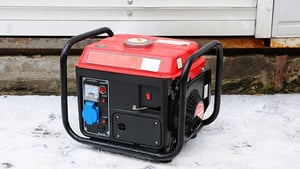 What if the grid does go down for days, and you can’t or don’t want to be without power for that long?
What if the grid does go down for days, and you can’t or don’t want to be without power for that long?
Whether you’re without power for a few hours or a few days, the energy you’ll need will vary a great deal. The unfortunate part about this is the uncertainty. While planning for the worst-case scenario may help you sleep more soundly at night, you could end up spending thousands of dollars on an expensive battery system that you may not (and hopefully won’t) ever need.
However, if this level of security appeals to you, you could potentially invest in both a battery backup system and a gas-powered generator.
Ranging from a few hundred to a few thousand dollars, natural gas-, propane-, or diesel-powered generators will provide you with plenty of electricity once your batteries have exhausted their charge, given you have the required fuel. You can find these at your local hardware store or online retailers, and setup is easy.
Generators are a less expensive way to boost the electricity your home or business has access to while the grid is down. For shorter-lived outages, you can rely on the convenient and green battery bank charged by your solar system. These can provide enough power to run your critical appliances until things are back up and running. For longer outages, you’ll have the option to switch to your generator to keep things running even longer while your battery system recharges.
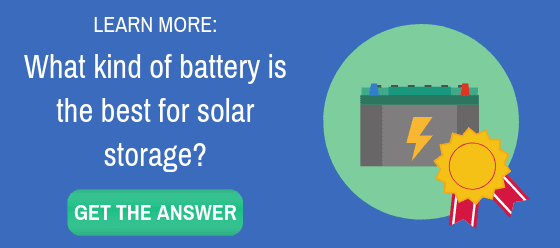
Unfortunately, whether a smaller portable generator or a larger standby generator, they don’t run on money-free and emission-free sunshine like your solar batteries. If running for days, your generator will require gallons of gas. Not only can that get expensive, but gas may be difficult to come by during a natural disaster.
Another thing to note is that generators can give off harmful fumes and make a lot of noise, which can make running them continuously difficult and disruptive.
Having both batteries and a generator may offer a well-balanced solution for your next power outage. You won’t be 100% dependent on outside fuel sources, but you also won’t have to invest a big chunk of change into a massive battery bank that you may never end up needing.

 What if the grid does go down for days, and you can’t or don’t want to be without power for that long?
What if the grid does go down for days, and you can’t or don’t want to be without power for that long?
